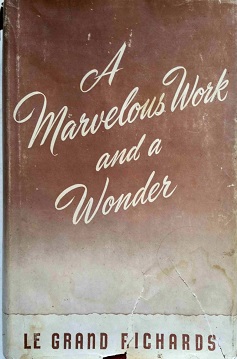Elder Thomas S. Monson wrote:
“LeGrand
Richards was also a choice individual with whom to work. It was my opportunity
to print for him the book A Marvelous
Work and A Wonder, as well as Israel,
Do You Know? When his manuscripts would come to us, they were prepared just
as he spoke—all in one sentence. It was necessary for his administrative aid,
Lee Palmer, from the Presiding Bishopric’s Office, to do a lot of editorial
work on Brother Richards’ manuscripts with regard to grammar and sentence
structure. I was impressed with the knowledge that LeGrand Richards would
accept no royalty for his books, feeling that he wanted to keep the price as
low as possible for the benefit of the membership of the Church. He still had a
mortgage on his home and could have used the royalty. In fact, as time was to
prove, A Marvelous Work and A Wonder became
a runaway bestseller and would have produced literally hundreds of thousands of
dollars for Brother Richards. He never regretted his decision and kept that
particular book under-priced on the market as long as he lived, thanks to his
refusal to accept a royalty. (Thomas S. Monson, On the Lord’s Errand [Salt Lake City: privately printed, 1985], 176-77.)
Regarding A Marvelous Work and a Wonder, in 1983
Elder Richards said:
That’s the greatest missionary book
the Church has got except the Book of Mormon. They sell more of it than any
book they have except the Book of Mormon. At the present time they have
distributed about two million copies; they distribute from fifty to a hundred
thousand copies a year; have done for the last five years here out of Salt Lake
and there is a printing plant over in England where they publish for all of the
British Isles, South Africa, Australia and New Zealand, and then it’s published
in eighteen different languages in other nations. I had written an outline for
my missionaries down in the South called “The Message of Mormonism.” I had that
mimeographed and gave them each a copy and when I came home I got so many
requests for that I said to myself—Why don’t I develop those outlines the way I
would present them if I were going into a home one night a week for six months
and that’s what brought the Marvelous
Work and a Wonder into existence. (https://www.youtube.com/watch?v=80icumy__CU;
go to 43:30)




